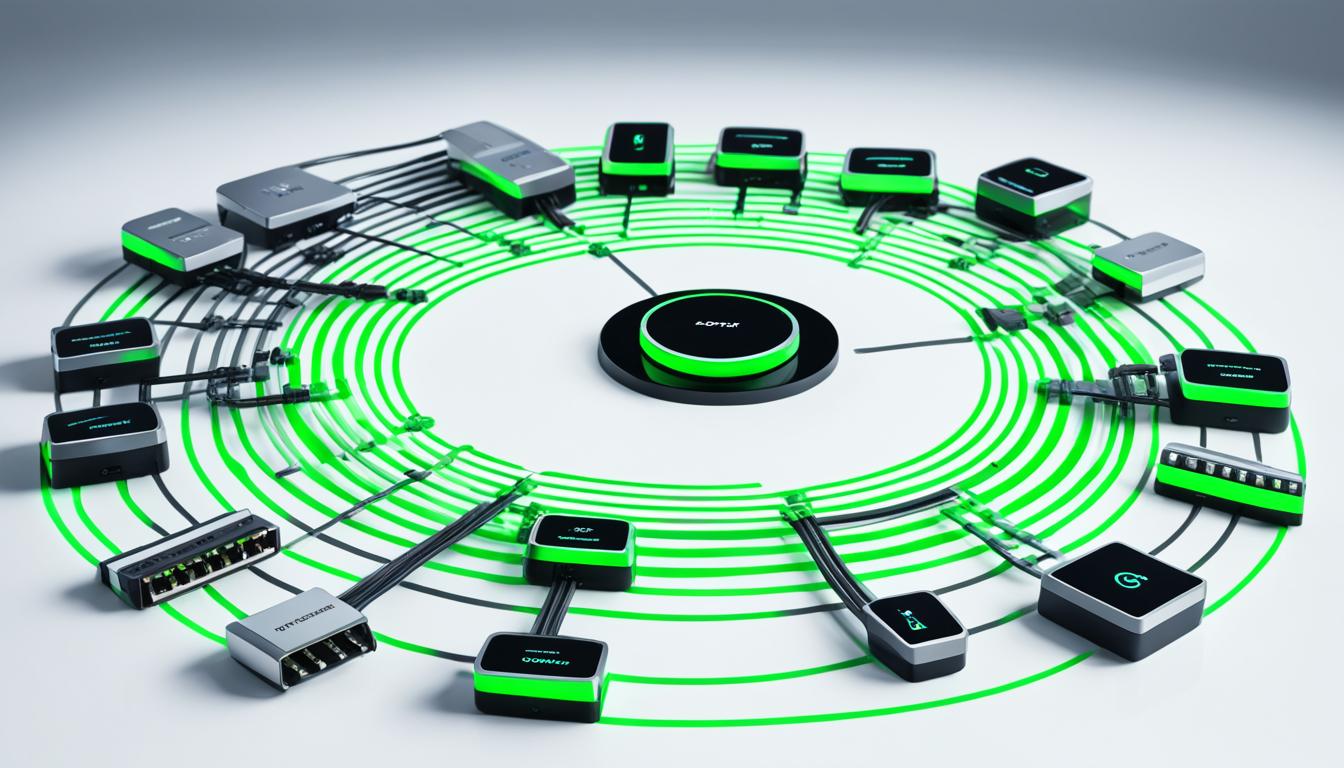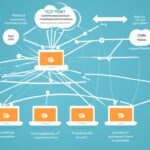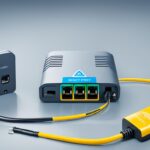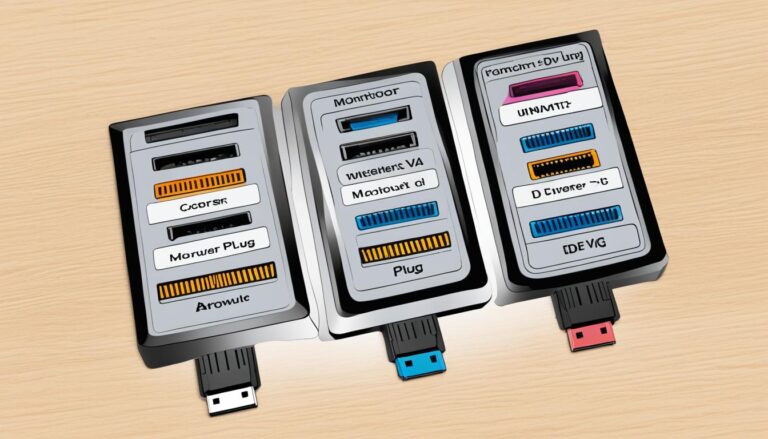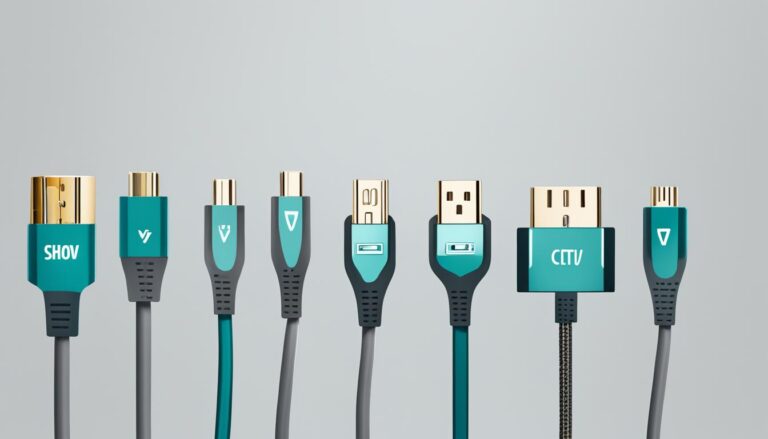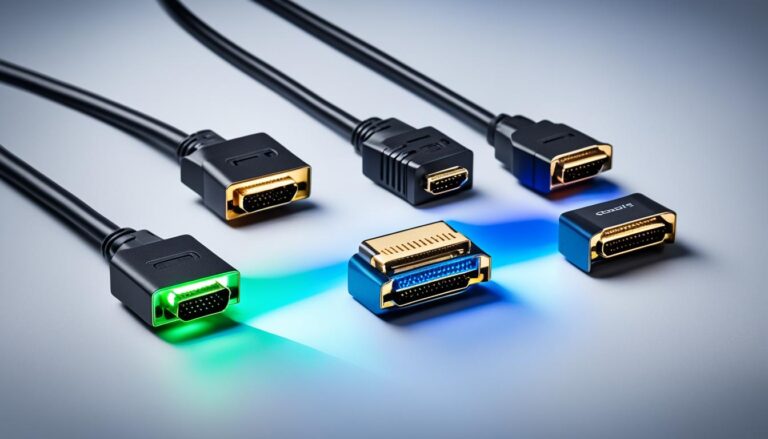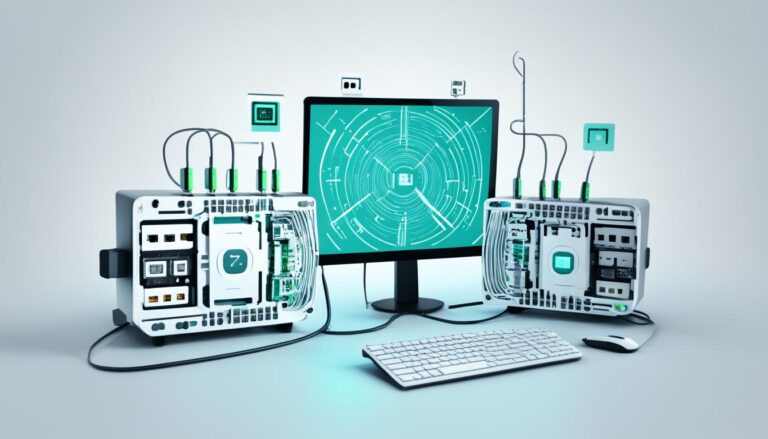In computer science, a logical port is seen as a special number. This number is for a “logical” connection that computers use to communicate. They use a system called TCP/IP and UDP. In total, there are 65,536 TCP ports and the same number of UDP ports. The range for these ports is from 0 to 65,536, including port 0 at the start.
The number of the logical port helps TCP/IP decide where to send the data. Port 8000 is often chosen for web development servers. It’s chosen because it’s not set aside for any particular services. Yet, computers can be set up to use different port numbers too.
Types of Ports: Physical vs. Logical Ports
Understanding the kinds of ports in computer networks is crucial. Ports are gateways for data to move, allowing devices to talk to each other. We’ll look at physical and logical ports here.
Physical Ports
Physical ports are the parts you can touch in network setups. They are the RJ-45 female jacks found on devices like switches and routers. These ports let you plug in network cables and connect devices directly to the network. They help devices share data.
Logical Ports
Logical ports are different because they’re not tangible. They are virtual connections with numbers for names. These numbers help protocols like TCP/IP and UDP send data to the right service or app. Logical ports make sure the right device gets the right data.
Logical ports are key in networks. They help sort out where data should go for each service or app on a device. They ensure your information reaches its destination.
Physical vs. Logical Ports: A Comparison
| Physical Ports | Logical Ports |
|---|---|
| Physical hardware components | Virtual connections |
| Used for establishing direct connections | Used for identifying and routing traffic |
| Examples: RJ-45 jacks, Ethernet outlets | Examples: TCP/IP and UDP port numbers |
Physical and logical ports have different roles in a network. Physical ports let devices connect. Logical ports help send data to the right place. This makes managing networks easier.
In short, physical ports are real parts that link devices. Logical ports are virtual connections that guide data traffic. Knowing the difference is key for handling network issues.
Understanding Port Ranges and Assignments
Port numbers help organize network traffic in computer networks. They are split into well-known ports, registered ports, and dynamic/private ports. This setup aids efficient traffic management.
Well-Known Ports
Well-known ports cover numbers from 0 to 1023. They are linked to common protocols or services for easy identification. Examples of well-known ports are:
- Port 80: HTTP, used for web traffic
- Port 443: HTTPS, used for secure web traffic
- Port 21: FTP, used for file transfers
- Port 25: SMTP, used for email delivery
Registered Ports
Registered ports range from 1024 to 49,151. The Internet Assigned Numbers Authority (IANA) assigns these to companies for their unique applications. This makes it easier to tell one company’s service from another’s.
Dynamic/Private Ports
Dynamic/private ports span from 49,152 to 65,535. They’re open for any application to use. Often, they’re chosen by the operating system for client ports in network connections. This helps apps communicate smoothly.
Knowing about these port ranges and their roles is key for managing networks well. By setting up and keeping an eye on these ports, network heads can keep systems talking to each other safely and efficiently.
| Port Range | Assignment Type |
|---|---|
| 0 – 1023 | Well-Known Ports |
| 1024 – 49,151 | Registered Ports |
| 49,152 – 65,535 | Dynamic/Private Ports |
Logical Port Security and Best Practices
All logical ports can be attacked, making computer systems open to threats. Hackers aim at well-known ports more, raising risks at these points. To fight this, admins must take steps like using security protocols and scanning for vulnerabilities.
Tools for scanning ports and finding vulnerabilities are used by attackers to find open ports. They use this to learn about services and systems on machines. Admins must keep an eye on ports to lessen risks and vulnerabilities.
To better secure ports, it’s key to close ones not in use. By doing this, admins cut down on ways hackers can get in. This act is crucial in keeping systems safe from attacks.
Putting firewalls in place is also critical. Firewalls block bad traffic between trusted and untrusted networks. They stop attacks by controlling what comes in and goes out of the network. This adds a strong layer of defence against threats.
Keeping on top of port security is important to protect against cyber risks. By staying vigilant and using these methods, admins can keep systems safe. They help in keeping out unauthorised access and keeping system integrity.
Best Practices for Logical Port Security:
- Regularly conduct port scanning and vulnerability scanning to spot weaknesses.
- Closely monitor and manage open ports to cut down attack chances.
- Close unnecessary ports to reduce hacker entry points and risks.
- Implement firewalls to sift through traffic and stop scanning attacks.
By adopting these practices, firms can boost their logical port security. This enhances their computer systems’ overall safety.
Conclusion
Ports, like port 8000, are not set in stone for computers. They’re often used for web development servers. But, different ports can serve specific needs. Knowing about logical ports and port ranges is key for managing networks and keeping computers safe.
It’s vital to close ports that aren’t in use and beef up security. Things like firewalls really help. They lower the chance of hacks and fix weak spots. This keeps the network running smoothly and safely.
Staying up-to-date with security and network tips is a must for keeping computers safe. Review and update security plans often. Check for vulnerabilities to stop risks early. With a focus on port security and best practices, computers can be more secure and dependable.
FAQ
Why is the logical port of my computer always port 8000?
Having port 8000 as the logical port is not required. It’s commonly chosen for web development servers. Yet, you can opt for different port numbers too.
What are the types of ports?
Ports come in two kinds: physical and logical. Physical ports include RJ-45 female jacks found on devices like switches and routers. Logical ports, however, are numbers for “logical” connections. They help TCP/IP and UDP in directing traffic to specific services.
How are port numbers divided?
Port numbers split into three ranges. These are well-known ports (0-1023), registered ports (1024-49,151), and dynamic/private ports (49,152-65,535).
Well-known ports support widely used protocols. Registered ports are for IT firms’ unique applications, assigned by the IANA. Meanwhile, dynamic/private ports serve any application, often acting as client ports.
How can I enhance logical port security?
Enhancing port security means closing ports you don’t need. You can also use firewalls. They filter traffic and block port scans.
Why is it important to close unnecessary ports?
Closing ports you don’t need makes your system safer. Especially well-known ports, as hackers often target them. This reduces your network’s weak spots.
